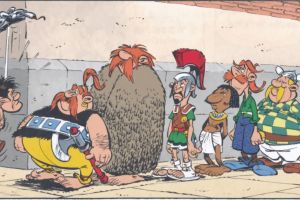Asterix and Racism
Understanding Prejudice in Ancient Rome and Asterix
In a previous article, we explored how Roman slavery was not motivated or justified on racial grounds. Slaves came from many different regions—Gaul, Greece, North Africa, Syria, Germany—and were enslaved due to war, debt, or birth, rather than skin color or inherited traits. Children of freed slaves could become Roman citizens, showing that ethnicity alone did not determine social status. This historical context helps us understand the kinds of prejudice Romans practiced and how similar ideas appear in the world of Asterix.

Roman Ethnocentrism and Environmental Determinism
While Romans did not use race as we understand it today, they had strong cultural and ethnic prejudices. They categorized peoples, or nationes, based on observed traits and customs. Gauls and Germans were often depicted as strong and brave, but uncivilized; Greeks and Easterners were clever and educated, yet sometimes seen as cunning or effeminate.
These judgments were often explained through environmental determinism, the belief that climate and geography shaped character. Northern peoples were thought to be hardy but less cultured, while southern peoples were described as passionate or lazy. Such thinking reflects cultural bias rather than innate inferiority and is similar to how Asterix depicts different groups.

Caricature in Asterix and Modern Sensibilities
Some visual caricatures in Asterix may appear striking or uncomfortable today. Early depictions of Black characters, for example, sometimes exaggerate lips or other features. Viewed through a modern lens, these images can seem offensive.
However, the overall approach of Goscinny and Uderzo aligns more closely with the Roman idea of people as products of their environment than with modern racial ideology. In Asterix, all groups are caricatured—Romans, Gauls, Britons, Egyptians, and Vikings—using exaggeration for humor and storytelling. This reflects the French tradition of caricature, which values satire and freedom of expression rather than singling out a particular ethnicity.
Of course the creators of Asterix noticed that sensebilities have changed. In the most recent Asterix adventure, Asterix in Lusitania, the appeareance of Baba has changed. He also lost his speech impediment.
Key Differences from Modern Racism
The main distinction between Roman prejudice and modern racism is mutability. In Rome, adopting Roman language, customs, and citizenship could allow anyone to rise socially, regardless of origin. Modern racism, by contrast, is an immutable, biologically-based hierarchy that permanently restricts people based on inherited traits. The Asterix comics, following Roman-style determinism and French caricature, exaggerate cultural traits rather than asserting any permanent racial hierarchy.

Conclusion
By linking historical Roman prejudice with the caricatures found in Asterix, we can better understand the intent behind the comics. While some images may seem jarring today, the creators’ goal was humor, cultural commentary, and storytelling, not modern racial stereotyping. Readers gain insight into both ancient attitudes toward different peoples and the long tradition of French satirical caricature.








